#QueSST
Text
everyones loved and hated gifts
love: mana is a universal love
bap- Flowers, Essence
corsac- Fungus, Flowers
luna- Fruit
mint- Bones, Plants, Slime
muttuk- Fish, Bone, Ore
quinn- Bug, Flesh, Slime
roxanne- Mineral, Gem
saff- Slime, Plant
s&p- Fish, Ores
xid- Bugs
-----
hate:
bap- Bones
corsac- Fish, Flesh
luna- Essence, Bugs (you get an achievement for giving her one)
mint- Fungus
muttuk- Plants
quinn- Fruit, Gem
roxanne- Flower, Fish
saff- Gem
s&p- Slime
xid- Mineral
#potionomics#i know xid is rich because who the hell likes gems but hates minerals. girl those are the same thing#xid potionomics#saffron potionomics#mint potionomics#salt and pepper#salt and pepper potionomics#baptiste potionomics#baptiste#corsac#corsac potionomics#muktuk#muktuk potionomics#quinn potionomics#roxanne potionomics#do not quote me but i thiiiink price may determine how much relationship goes up? idk. if you want max friendship in one run#i just bulk bought cheap ingerdients fromm quinn and everyday i would instantly leave and give veryone one (1) gift#hangouts arent needed at first but it helped me get corsac to level 10. pacing out relationship quessts is the hardest part imp
5 notes
·
View notes
Text
NASA, Lockheed Martin Reveal X-59 Tranquilo Supersónico
¡Es una noticia emocionante! El X-59 tiene el potencial de cambiar las reglas del juego para los vuelos supersónicos.
El X-59, presentado recientemente por la NASA y Lockheed Martin, no es solo un avión promedio. Es una máquina de ensueño elegante y alargada, que se extiende casi 100 pies desde la nariz hasta la cola, con una envergadura más ancha que una cancha de baloncesto. Su diseño no es…
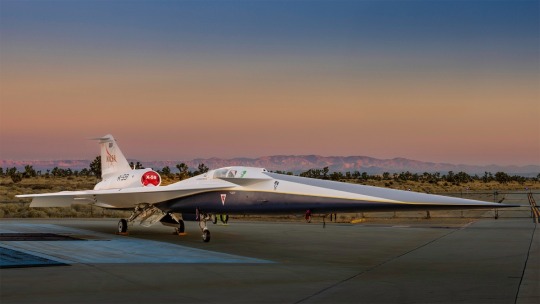
View On WordPress
#aerodinámica#aeronáutica#Centro de investigación ames#Centro investigación glen#Estudios#NASA#Prueba de vuelo#Quesst vuelo super sonico
0 notes
Text
NASA to Participate in Space Symposium, Discuss Moon to Mars Strategy Implementation Through Artemis
NASA is one of the most renowned organizations in the world, and it is known for its contributions to the scientific world. The organization has been at the forefront of space exploration for decades and has made significant strides in discovering more about the universe. Recently, NASA announced that it would be participating in the Space Foundation’s 38th Annual Space Symposium, where NASA…

View On WordPress
#Artemis#human exploration#James Free#James Webb Space Telescope#Jim Reuter#Kenneth Bowersox#Moon to Mars#NASA#NASA TV#Nicola Fox#Pam Melroy#Robert Gibbs#space exploration#Space Symposium#space technology#subject matter experts#sustainable lunar presence#universe discovery#X-59 Quesst mission
1 note
·
View note
Photo
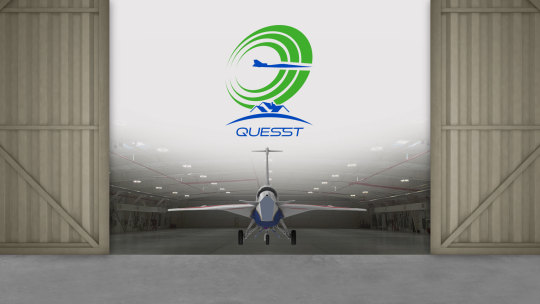
Introducing Quesst: Speed Never Sounded So Quiet via NASA Quesst is what NASA is calling its mission to enable supersonic air travel over land. https://ift.tt/WjOg2ia
0 notes
Photo

Introducing Quesst: Speed Never Sounded So Quiet #NASA https://ift.tt/yaQRews
0 notes
Text
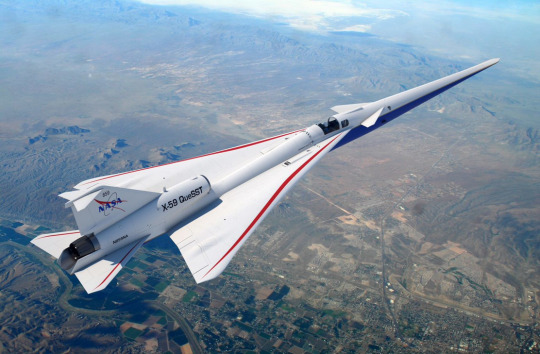
Lockheed Martin X-59 "QuessT"
The Lockheed Martin X-59 Quiet Supersonic Transport (QuessT) experimental supersonic aircraft being developed at Skunk Works for NASA's Low-Boom Flight Demonstrator project. Preliminary design started in February 2016, with the X-59 to be delivered to NASA in 2021 for flight testing in 2023.
128 notes
·
View notes
Text
NASA Targets 2024 for First Flight of X-59 Experimental Aircraft
https://enterprisewired.com/wp-content/uploads/2023/10/NASA-Targets-2024-for-First-Flight-of-X-59-Experimental-Aircraft.jpg
Share Post:
LinkedIn
Twitter
Facebook
Reddit
NASA’s Quesst mission has postponed the inaugural flight of its X-59 quiet supersonic aircraft to 2024. The X-59, an extraordinary experimental aircraft, has posed intricate engineering challenges for NASA researchers collaborating with the primary contractor, Lockheed Martin Skunk Works. Apart from its unique design, the X-59 incorporates innovative technology and components from various established aircraft, including its landing gear from an F-16 and its life-support system adapted from an F-15.
Additional time is required to integrate systems into the aircraft
Given the complexities involved in developing this exceptional aircraft, the Quesst team is diligently addressing several technical issues identified during the course of 2023, when the X-59 was initially slated for its maiden flight. Additional time is required to seamlessly integrate systems into the aircraft and ensure their proper functioning. The team is also resolving intermittent problems with some of the safety-redundant computers that oversee the aircraft’s systems.
Over the past year, Quesst has made consistent progress towards flight readiness. The team completed the finishing touches on the X-59’s tail structure, allowing them to finalize its electrical wiring and advance to critical ground tests. They also moved the aircraft from its assembly facility to the flight line for structural testing.
The X-59’s primary objective is to demonstrate the capability to achieve supersonic flight, exceeding the speed of sound, while minimizing the typical disruptive sonic boom to a subdued sonic thump. NASA intends to conduct flights over several communities to collect data on how people perceive the noise it generates. This data will be provided to U.S. and international regulators to potentially revise regulations that currently prohibit commercial supersonic flight over land.
Lockheed Martin X-59 finally unveiled in hangar rollout
youtube
Fully committed to a meticulous review and testing process
NASA places paramount importance on safety and mission success. For Quesst, this entails ensuring the X-59’s safety before it takes flight and ensuring its long-term reliability during the community test phase. The aircraft is currently undergoing comprehensive integrated testing, which must be successfully completed prior to its inaugural flight. Following this stage, the aircraft will proceed to a flight readiness review, during which NASA will unveil a more specific timeline for the first flight.
Quesst represents a mission with the potential to transform commercial aviation travel by significantly reducing travel times. Safely and reliably deploying the X-59 is crucial for NASA to realize the benefits of this mission. The agency is fully committed to a meticulous review and testing process to ensure the mission’s success.
Read More: New Asteroid Search Algorithm Detects Its First Dangerous Space Rock
20 notes
·
View notes
Text
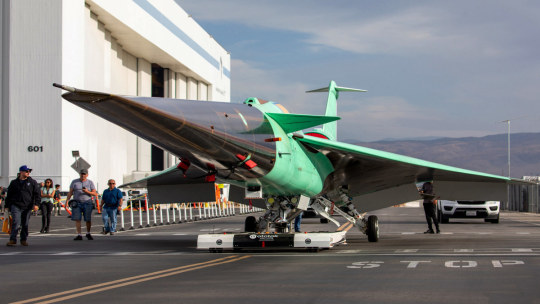
NASA postpones X-59 flight tests to 2024
Fernando Valduga By Fernando Valduga 10/20/2023 - 10:01am in Technology
NASA postponed the first flight of the X-59 low-noise supersonic demonstrator to 2024, after a series of subsystem problems found during verification tests at Lockheed Martin's Skunk Works facility in Palmdale, California, later this summer, proved more difficult to solve than expected.
"We want to fly as early as possible, but we want to fly safely," says the agency, which - together with Lockheed Martin - has solved a variety of problems of abandonment and redundancy of security systems in various subsystems.

First reported in August, the problems are related to the flight control computer and the hydraulic system and were found during structural coupling tests in Palmdale. The coupling tests were designed to evaluate the interaction between the fuselage and the flight control system, and to ensure the absence of any aeroelastic and aeroservoelastic instabilities.
Developed by Lockheed for NASA's Quiet Supersonic Technology (QueSST) program, the X-59 almost 30 meters long was originally supposed to fly in 2021. However, the latest system-related delays add to a series of delays that included workforce hiring issues, the pandemic and technical challenges related to cabling and the integration of final systems. Until recently, the agency still expected to make the first flight of the X-59 by the end of the year, with a transition soon after to NASA's neighboring Armstrong Flight Research Center at Edwards Air Base for subsequent expansion of the envelope.

Commenting on the delay, NASA states: “This unique experimental aircraft requires unique and complex engineering, and its team encountered several technical challenges last year. The X-59 is currently in the process of integrated testing, which must be completed to help ensure safe and successful flights. NASA plans to release a more specific schedule for the first flight when the flight readiness review is completed, after integrated tests."
The X-59 is designed to collect community response data on the public acceptability of reduced sonic rons. The data will be used by U.S. and international authorities to determine whether a growth standard can be established that allows the release of the current ban on civilian supersonic flights over land, which has been in force since the 1970s.

However, to achieve low-intensity sonic sonic roning at the projected speed of the X-59 of Mach 1.4, the aircraft is configured with a well-sloping hang glider and swinging extended nose section that represents more than one third of the length of the vehicle. Specifically designed with rigidity for high-speed testing, rather than resistance for payload capacity, the long and slender format therefore presents significant aeroelastic challenges.
Source: Aviation Week
Tags: Lockheed MartinNASAQueSST - Quiet Supersonic TechnologyTechnologysupersonic flightX-59
Sharing
tweet
Fernando Valduga
Fernando Valduga
Aviation photographer and pilot since 1992, has participated in several events and air operations, such as Cruzex, AirVenture, Dayton Airshow and FIDAE. He has work published in specialized aviation magazines in Brazil and abroad. Uses Canon equipment during his photographic work in the world of aviation.
Related news
MILITARY
Philippine Air Force acquires Lockheed C-130J-30 Super Hercules aircraft
19/10/2023 - 22:41
Bombardier solidifies its leading position in sustainable aviation and continues its work of defining the industry in the EcoJet research project, accelerating the second phase of testing.
TECHNOLOGY
Bombardier accelerates second phase of testing of the EcoJet research project
17/10/2023 - 16:00
Lockheed Martin received a contract from the U.S. Navy to build eight MH-60R helicopters Seahawk for the Spanish Navy. In the photo, a U.S. Navy MH-60R aircraft.
HELICOPTERS
Lockheed Martin receives contract to manufacture eight MH-60R Seahawk helicopters for the Spanish Navy
15/10/2023 - 20:05
HELICOPTERS
VIDEO: Airbus demonstrates single piloting joystick to replace three helicopter pilot controls
13/10/2023 - 13:00
Boeing ecoDemonstrator Explorer, a United Airlines 737-10, will fly in SAF, followed by NASA's DC-8 Airborne Science Lab measuring non-CO2 emissions.
COMMERCIAL
Boeing, NASA and United Airlines will test SAF benefits with flight formations of a DC-8 and a 737-10
13/10/2023 - 08:02
EVTOL
Boeing's Wisk Aero starts new flight tests with its eVTOL in Los Angeles
09/10/2023 - 11:00
10 notes
·
View notes
Photo

Supersonic travel, without the sonic boom Supersonic aircraft generate a series of shock waves that merge into two distinct booms. The planes drag these incredibly loud sounds along their flight path, creating unacceptable noise levels over land. So far, sonic booms have prevented commercial supersonic flight over land, but fixing the noise could cut flight times in half. At the 183rd Meeting of the Acoustical Society of America, Gautam Shah of NASA Langley Research Center will present "NASA Quesst Mission – Community Response Testing Plans," in which he will discuss the plans to test a supersonic aircraft with technology to reduce sonic booms. The presentation will take place Dec. 6 at 10:50 a.m. Eastern U.S. in the Summit B room, as part of the meeting running Dec. 5-9 at the Grand Hyatt Nashville Hotel. "NASA's X-59 aircraft is intended to validate and demonstrate the design tools and technologies that make it possible to design an aircraft with a different shape that alters how supersonic shock waves behave," said Shah. "Instead of coming together to be heard as a loud boom, the shock waves do not merge. They rapidly weaken, resulting in a sound more like a soft thump." NASA will conduct a series of flights over various communities across the U.S. Shah and his team will measure the sound of the aircraft and conduct public surveys to understand the public response to different noise levels. By providing this information to regulatory agencies, the group hopes to inform an overland supersonic sound standard. The first flight will take place in 2023, followed by 18 months of testing to confirm the aircraft's performance and safety. From 2025 through 2026, NASA intends to conduct a series of four to six community tests at locations across the country, eventually delivering the data to regulators in 2027. More details can be found on the mission website. NASA has also developed a Quesst Mission Supersonic STEM Toolkit, which includes activities and educational material related to acoustics and flight.
21 notes
·
View notes
Photo
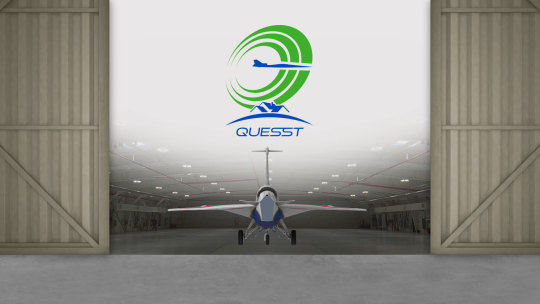
Introducing Quesst: Speed Never Sounded So Quiet via NASA https://ift.tt/yaQRews
2 notes
·
View notes
Photo
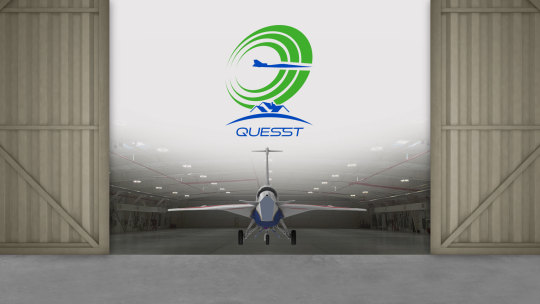
Introducing Quesst: Speed Never Sounded So Quiet via NASA https://ift.tt/yaQRews
2 notes
·
View notes
Text
NASA, Idea de exploración de la industria
El Programa de Vehículos Aéreos Avanzados (AAVP) de la NASA está pasando ahora a la siguiente fase de investigación sobre viajes de alta velocidad, que incluye la emisión de dos contratos de 12 meses a empresas
22 de agosto de 2023
¿Es posible un avión de pasajeros Mach 4? NASA, Idea de exploración de la industria
Volar de Nueva York a Londres hasta cuatro veces más rápido de lo que es posible actualmente puede parecer un sueño lejano, pero la NASA está explorando si el mercado comercial podría soportar viajes a tales velocidades.
La NASA investigó recientemente el caso comercial de los viajes aéreos…

View On WordPress
0 notes
Photo

Introducing Quesst: Speed Never Sounded So Quiet
via NASA https://ift.tt/yaQRews
3 notes
·
View notes
Photo

Introducing Quesst: Speed Never Sounded So Quiet #NASA https://ift.tt/WjOg2ia
0 notes
Text
NASA'nın X-59 uçağı süpersonik suratlara minimal ses patlamasıyla ulaşıyor
New Post has been published on https://bilaldemirkr.com.tr/nasanin-x-59-ucagi-supersonik-suratlara-minimal-ses-patlamasiyla-ulasiyor/
NASA'nın X-59 uçağı süpersonik suratlara minimal ses patlamasıyla ulaşıyor
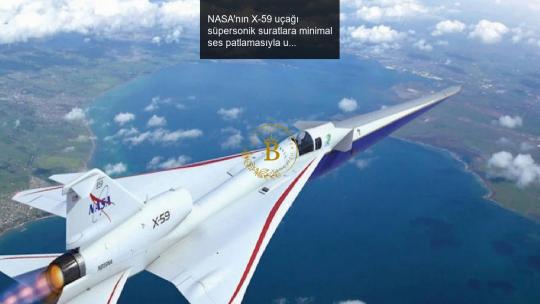
NASA ve Lockheed Martin işbirliği ile geliştirilen X-59 Quesst süpersonik ticari jet, havacılık dünyasında yeni bir sayfa açmaya hazırlanıyor. Bu proje, Lockheed Martin’in Kaliforniya, Palmdale’deki Skunk Works tesislerinden dramatik bir formda ortaya çıkışını canlı yayında gösterecek. 247.5 milyon dolarlık Quesst, ismini “Quiet SuperSonic Tech”ten alıyor ve aslında sessiz bir süpersonik teknolojiyi temsil ediyor. NASA, 2018 yılından bu yana, X-59’un kentlerin üzerinden gürültü kirliliği yahut ses patlamaları yaratmadan uçabileceğini kanıtlamak için bir misyon üzerinde. Bu test uçuşu, altı yıllık projenin değerli bir kilometre taşını işaret ediyor.
İlk uçuş, 12 Ocak’ta Türkiye saati ile gece 00:00’da YouTube üzerinden, ayrıyeten NASA uygulaması ve NASA+ yayın hizmeti üzerinden canlı olarak yayınlanacak. Uzay ajansı, jetin birinci uçuşu sırasında insanlardan duydukları sesler hakkında anket yapmayı planlıyor. Lakin, bu insanların nasıl bulunacağı yahut kaç kişinin ankete katılacağı belirtilmemiş. Toplanan datalar, düzenleyicilere gönderilecek ve süpersonik jetlerin kullanımını sınırlamak gayesiyle yeni kurallar önermekte kullanılacak. ABD federal hükümeti, yarım asırdan fazla bir müddettir tüm sivil süpersonik jetlerin karasal alanlar üzerinde uçmasını yasaklamıştı.
NASA’nın X-59 uçağı süpersonik suratlara minimal ses patlamasıyla ulaşıyor
NASA, 2018 yılında sessiz süpersonik teknoloji projesini duyurduğunda, yönetici Jim Bridenstine, “Bu uçağın, Amerika Birleşik Devletleri’nde havacılığı dönüştürme potansiyeline sahip olduğunu” söylemişti. Jetin birinci uçuşu 2021’de planlanmış olmasına karşın, bugünkü birinci uçuş hâlâ QueSST misyonunda değerli bir dönüm noktası. NASA, 2027 yılına kadar yeni uçak teknolojisinin uçuş gürültüsünü azaltma konusundaki aktifliği hakkında daha kesin sonuçlara sahip olmayı bekliyor.
Eğer süpersonik jet uçaklarının karaya yakın uçmasına müsaade veren yeni yasalar sonunda kabul edilirse, yüksek süratli ticari uçuşlar gerçeğe dönüşebilir. NASA ve Lockheed Martin, uçağın geliştirilmesini tamamladıktan sonra, ajans yaklaşık dokuz ay boyunca güvenlik değerlendirmeleri yapacak. Quesst uçağının güvenli bir biçimde uçabileceğini kanıtlamak için kâfi ispat paylaşıldıktan sonra, NASA uçuş testlerini ABD’nin çeşitli kentlerine genişleterek daha fazla gürültü bilgisi toplamak için ek anketler yapmayı planlıyor.
0 notes